- Materials Properties
- Types of Mat Materials
- PVC
- Natural Rubber
- TPE
- NBR
- PU+Natural Rubber
- EVA
- Jute
- Cotton & Hemp
- Cork
- Best Yoga Mat Material

Before you buy your first yoga mat, are you wondering what are these yoga mats made up of?
Well, it’s a valid concern. Especially, since the materials used in yoga mats are not only important for your practice but also a safety gauge for your skin and overall health. And only once you know the makings of your yoga mat, you will be able to buy the best one available.
Today yoga mat manufacturers are using a variety of synthetic and natural materials to make yoga mats comfy, at the same time ensuring it’s recyclable and eco-friendly.
Most commonly today synthetic yoga mats on market are made of Polyvinyl Chloride (PVC), Thermoplastic Elastomer (TPE), and Polymer Environmental Resin (PER). On the other hand, natural yoga mat materials include jute, cotton, cork, and natural rubber which are comparably more environment-friendly.
In this article, we will see different types of materials used to make yoga mats. Then based on the good and bad sides of each mat material, we will analyze which type of yoga mat is best based on its manufactured material.
Before we start, let’s briefly see what are some properties of common yoga mat materials.
Properties of Mat Materials
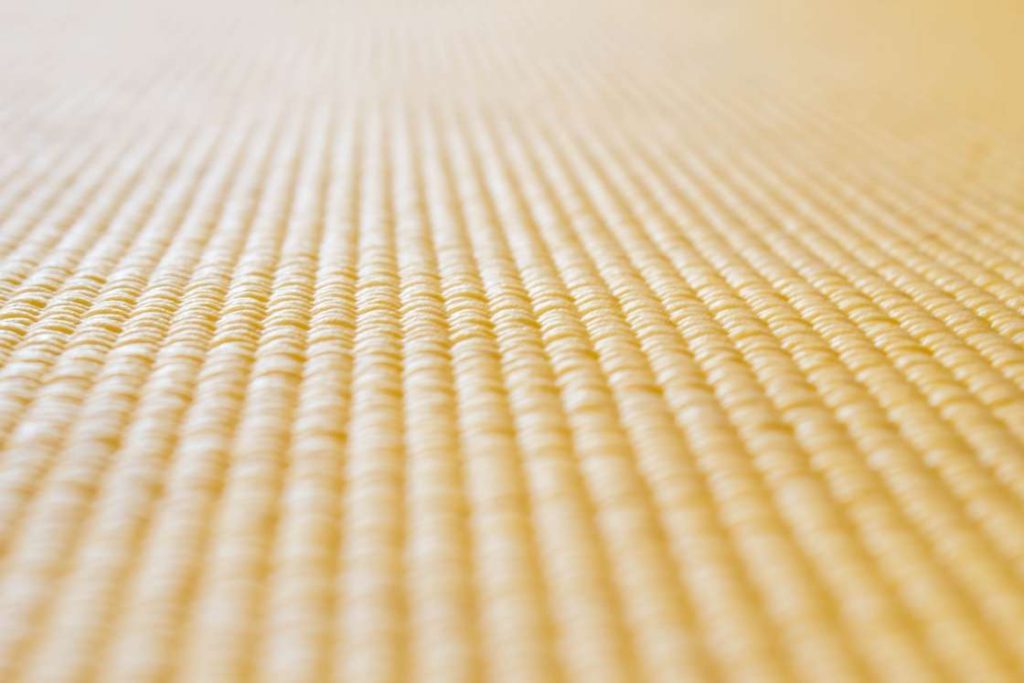
Each yoga mat material has some pros and cons that make it easier for a beginner to choose a good yoga mat from multiple options available in the market. Checkpoints of mat material include stickiness, durability, thickness, texture, absorption, cell construction of a yoga mat, and the traction it provides in stretching postures. Above all that, you (as a conscious yogi) should keep in mind whether or not mat material is friendly for the environment.
While selecting a yoga mat, keep the following properties of mat material in mind.
- Tactile texture: The more textured the surface of your mat is, the better it will be for grip. A textured surface will generate more friction on contact, which will prevent slipping. Mat material with more tactile texture will also support your posture balance. Generally, when natural fibers are used as materials that create better tactile texture.
- Thickness: The thickness of your mat will be determined by the total quantity of material packed in your mat. A thick mat will provide you with better comfort and cushioning. On the contrary, thickness will reduce the portability.
- Breathability: The breathability is determined by the density of material in your mat. The higher the density of your mat, the lesser will be the breathability. A breathable yoga mat will promptly absorb body heat and dissipate it. However, a greater density will increase the cushioning. You need the right balance of density. Neither high enough to hinder breathability nor low enough to reduce cushioning.
- Free of harmful chemicals: Certain cheap variants of PVCs and EVAs can pose potential health hazards. The synthesis of such materials uses chemicals that can cause irritation to the skin, and may even emit toxic gases on reacting with the surrounding. Such chemicals also tend to have a strong bothersome smell. Once again mats made of natural fibers are best when it comes to health.
- Durability: The performance quality of your yoga mat will determine the durability of its material. Factors like heat resistance, weather resistance, tactile strength, abrasion resistance, compression and elasticity, all build the durability of your material. Mats build from synthetic polymers like PVC, Polyurethane, NBR, PER, and TPE are all very durable.
- Eco-friendly: Yoga mat materials that are renewable, biodegradable, and leave a minimum carbon footprint on production, are considered eco-friendly. Most industrial-grade materials leave a hefty carbon footprint and take up to 1000 years to biodegrade. Obviously enough the natural fibers win when it comes to eco-friendliness.
- Flexibility and weight: Lightweight materials like TPE and cotton yoga mats are extremely easy to carry around. Mats made from these materials are also very flexible, that bend and fold easily.
- Moisture absorption: Porous materials like hemp, jute, cotton, and cork have high fluid and moisture absorption capacity. This property will prove particularly helpful when you sweat a lot on the mat. You need to consider this property even if you reside in a location with high moisture level.
- Insulation: Most of the natural fibers, rubber being an exception, are good conductors of electricity and heat, which give them a poor insulation ability. The synthetic materials on the other stop the passage of electricity and heat, which is helpful in preventing certain accidents.
Also Read: 11 Best Non-Slip Yoga Mats for Better Grip in Every Pose
Different Types of Yoga Mat Materials
In modern times you will come across yoga mats made from different materials. Each material has its own set of pros and cons. Whilst some mats are more durable some are more comfortable. Whilst some provide better grip, some are more eco-friendly. You need thorough awareness of the positives and negatives of each material, and accordingly, decide the right fit for you.
1. PVC (Polyvinyl Chloride)
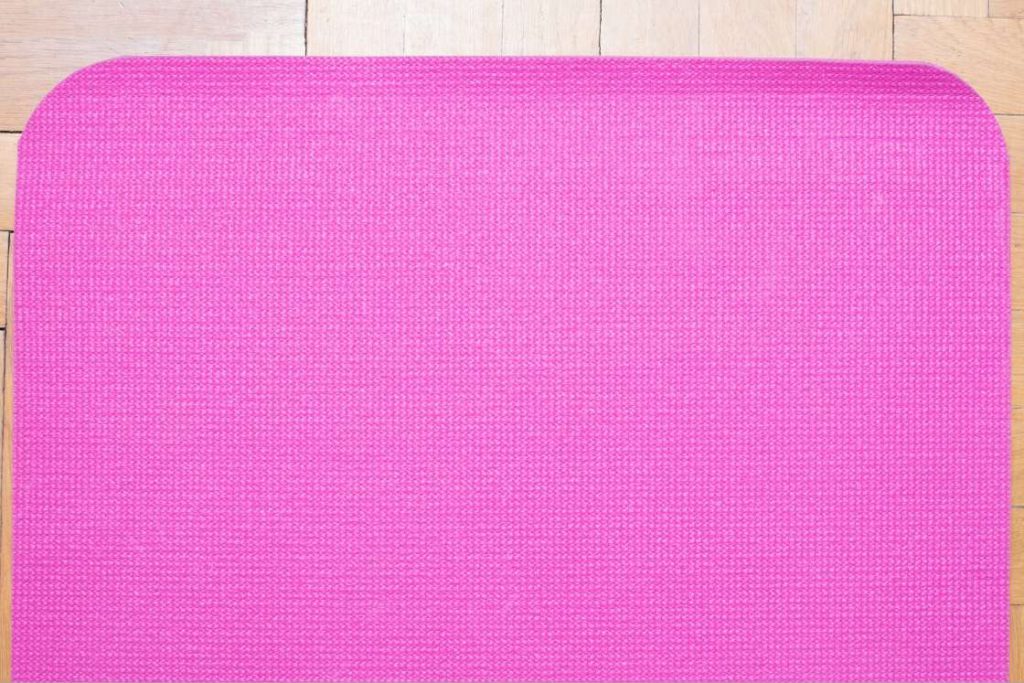
Polyvinyl Chloride or otherwise known as vinyl is the most common and cheap material used to make yoga mats. It’s a synthetic plastic polymer or a hydrocarbon product that makes PVC cheap, lightweight, super grippy, and flexible.
PVC yoga mats come with a great range of variety to their quality. Some companies produce low-quality PVC yoga mats at low cost. Whereas some PVC mats are produced with high-density, for increased cushioning and moisture proofing. PVC has an environment-friendly variant which is known as Polymer Environmental Resin.
Pros of PVC Yoga Mat
- The main attraction of PVC yoga mats is the product price. The PVC mats are one of the cheapest available products on the market.
- The second most important reason for the popularity of PVC is its durability.
- The durability of PVC mats, lead up to yet another benefit, they are easy to store.
- The PVC mats are not called sticky mats for any reason. These mats efficiently stick and hold on to the ground. Thus, reducing your chances of slipping during a pose.
- PVC is an extremely common material in today’s world, thus making it easily available in almost any market.
- If the PVC mat is a high-density mat, then the grip and cushion are also superior.
- High heat and fire resistance.
- Oil and Chemical resistance.
Cons of PVC Yoga Mat
- The biggest disadvantage of PVC is its environmentally hazardous nature. The PVC mats can take up to 1000 years to biodegrade. And the process of biodegradation too can release an alarming level of toxins in the environment.
- The low-quality PVC mats are not very friendly to your skin. The chemical (phthalates) used to keep the plastic malleable and supple can cause skin rashes.
2. Natural Rubber
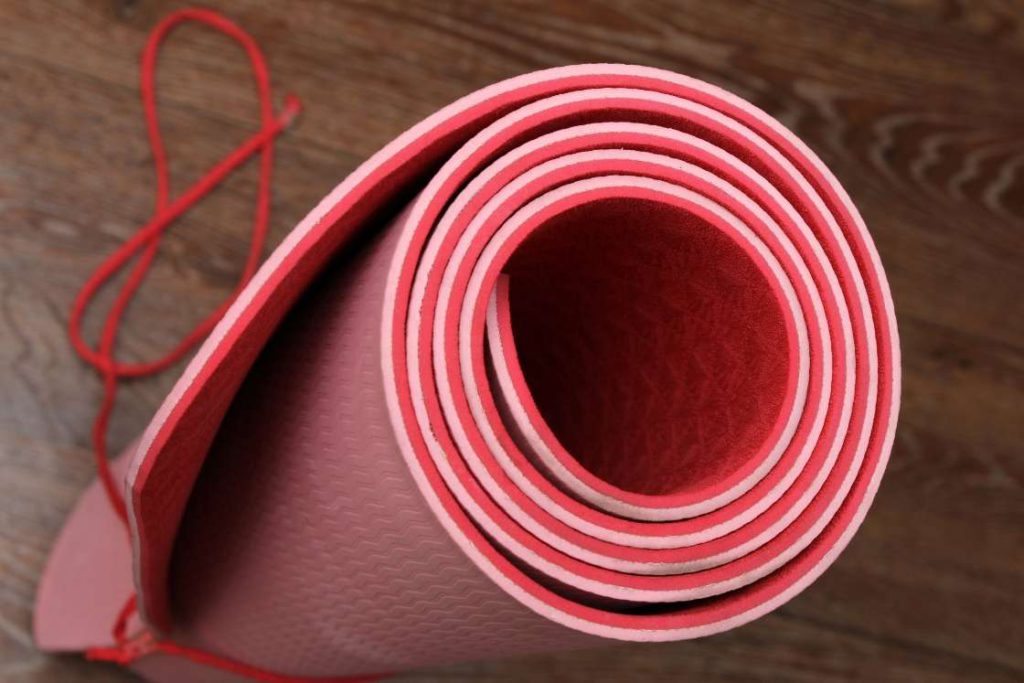
Natural rubber is probably the best material option there is for yoga mats, and has been in the market for a very long time; longer than foam and PVC. The rubber for these mats derived from nature, Hevea brasiliensis rubber tree, and is thus very easily biodegradable. The natural rubber yoga mats have a slightly hard surface, but they make up for it with their firm grip.
Note that this should not be confused with synthetic industrial-grade rubber. Natural rubber as a material is composed of organic polymers, few other organic impurities, and water.
Pros of Natural Rubber Yoga Mats
- The rubber mats have the minimum environmental threat. So if being eco-friendly is important to you, this can be your go-to mat.
- The rubber mats are dense, heavy, and have a very firm grip.
- Naturally hard yet flexible rubber provides a great cushion, and can even break fall impacts.
- The natural rubber mats are high on durability as well; truly returning you your money’s worth.
- High tensile strength, reduces tearing.
Cons of Natural Rubber Yoga Mats
- The biggest drawback of natural rubber yoga mats is their price. The price is quite high when compared to its alternative material.
- Natural rubber mats can be thick, heavy, and have a strong smell. These could add up to be a negative superficial user experience. However, this cannot be considered as a general drawback, as not all practitioners will find these qualities to be negative.
- Thick and heavy rubber mats can be difficult to handle and travel with. However, you will find ultra-thin rubber mats in the market that have easy handling.
- Building up on the previous point, the ultra-thin rubber mats compromise considerably on durability. So eventually, you will have to make a choice between durability and portability.
3. TPE (Thermoplastic Elastomer)
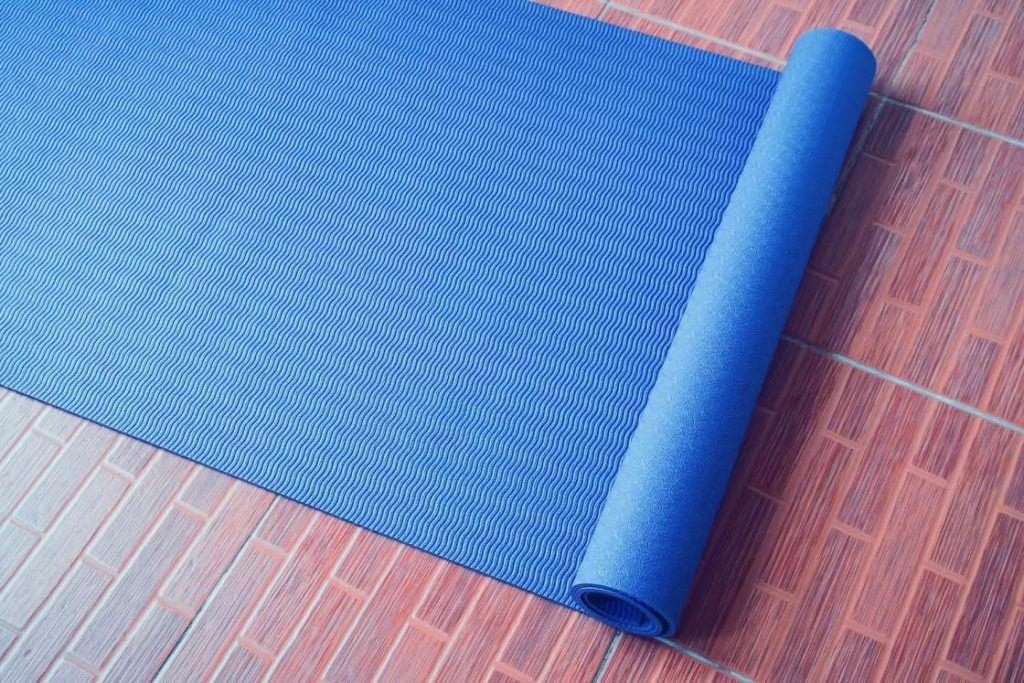
TPE or Thermoplastic is yet another popular and modern alternative material for yoga mats. This material is basically a mix of plastic and rubber, and thus, you get the best of both worlds. TPE has both thermoplastic properties and elastomeric properties. The thermoplastic properties make these mats recyclable, strong, bendable, shrink resistant, lightweight, impact-resistant, and chemical resistant. Whereas the elastomeric properties make these mats, flexible, heat resistant, and long-lasting.
Pros of TPE Yoga Mats
- The thermoplastic qualities make TPE mats recyclable
- The TPE mats are highly durable and long-lasting
- The TPE mats with their mix of rubber, have a good grip and cushion.
- This material is very cost-effective when compared to other eco-friendly materials.
- The lightweight of these mats makes them travel-friendly.
- The flexibility of the material also makes folding these mats very easy.
- These mats are odorless and decently friendly to your skin.
Cons of TPE Yoga Mats
- A major disadvantage is that TPE yoga mats don’t absorb or retain moisture, which is good, considering it makes the cleaning convenient. However, the moisture sticking to the body can increase slipping chances, and reduce friction.
- This material is also sensitive to sunlight, so you will have to avoid practicing in the open with TPE mats, and store it away from sunlight. Sunlight can significantly deteriorate the quality.
4. NBR: Synthetic rubber
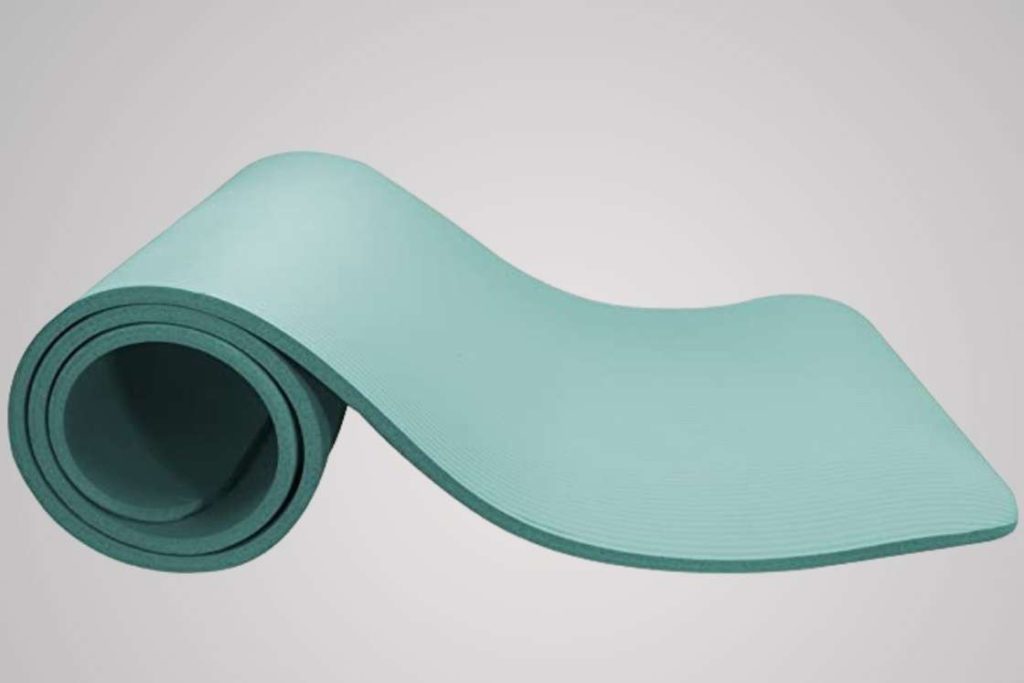
Synthetic Rubber is your typical industrial-grade rubber, something you will find commonly being used in automobiles. Synthetic rubber has high performance and durability but leaves a prominent carbon footprint. NBR or Nitrile Butadiene Rubber has very good insulation and equally good cushioning.
Check Manduka X Yoga MatPros of NBR Yoga Mats
- Synthetic rubber is highly durable and will last you significantly long.
- NBR is very cost effective, and is available at different prices.
- NBR mats will provide good posture grip and balance.
- This mats will not retain heat and not absorb electric shocks. So these mats are more accident proof as compared to the natural materials.
- The NBR mats face low wear and tear damages, making them perfect for regular rough usage.
Cons of NBR Yoga Mats
- NBR mats are very hazardous to the environment. However, the material can be processed to degrade by using additives.
- The manufacturing of NBR is limited to the USA, Europe, and Canada, so availability might be an issue
5. Natural Rubber and Polyurethane (PU)
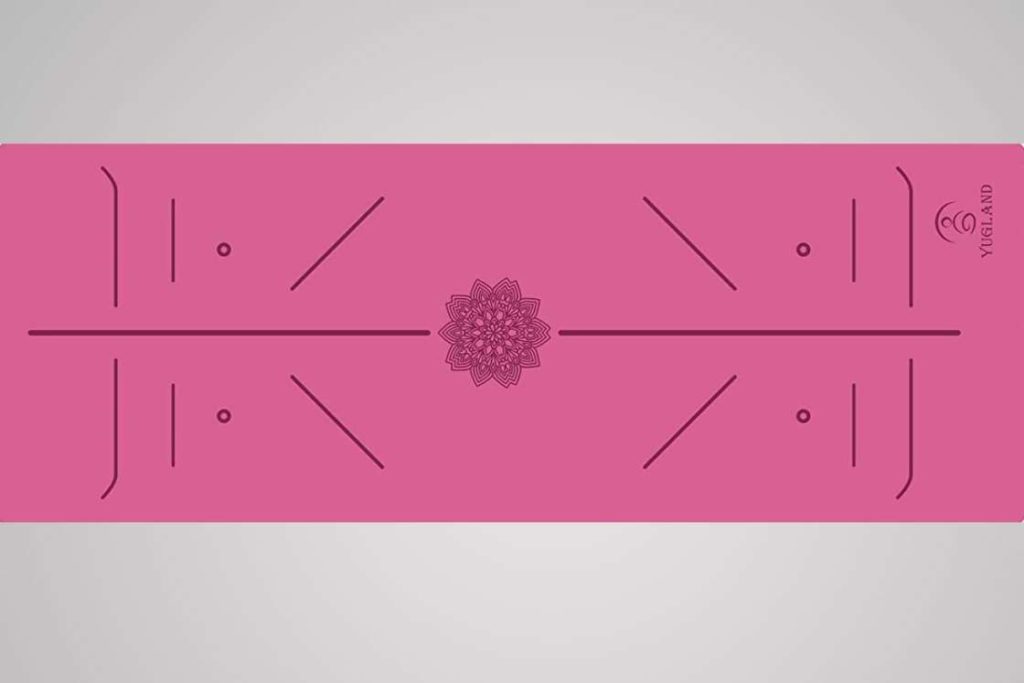
This material is an innovation of the current times and is a genuinely worthy consideration. Yoga mats made of a combination of natural rubber and polyurethane material blends the texture and sustainability of natural materials and the toughness and durability of industrial synthesizing.
The natural rubber itself is a great material for a yoga mat like we have discussed earlier. Polyurethane is essentially biodegradable plastic. Now adding Polyurethane to it makes the mat better insulated, flexible, and cushioned, which are otherwise unavailable with natural rubber. Adding Polyurethane also cuts down on the cost of pure rubber.
Pros of PU+Natural Rubber Yoga Mats
- Highly durable yet highly biodegradable. This material can biodegrade within 1-5 years, which is miraculous when compared to the 500-1000 years span of PVC.
- Eliminates chances of an accident by avoiding heat and shocks absorption.
- The rubbery quality gives these mats the perfect grip required for better posture and balance.
- It lasts longer with high abrasion resistance.
- The high flexibility provided by polyurethane makes the mat more portable.
- The combination of two materials gives this mat the perfect degree of softness and toughness. You get the right balance of cushion.
- These mats generally have more rubber in the base which will give it a sticky nature and have more polyurethane on the top, which will easily help you clean off the sweat from the surface.
Cons PU+Natural Rubber Yoga Mats
- Although these mats will come cheaper than pure rubber, they will still be expensive when compared to the likes of PVC.
- This material is relatively new to the market, so the ease of availability could be a bit less
6. EVA (Ethylene Vinyl acetate)
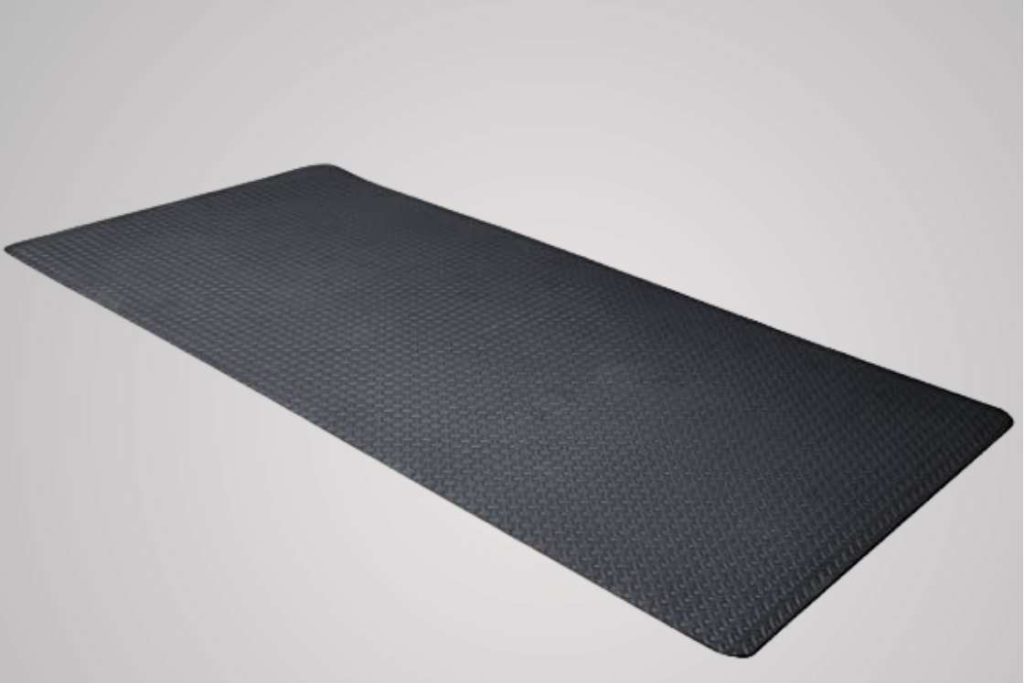
EVA is a cost-effective variant of foam. It does not wear off as quickly as the usual variants of foam. The EVA mats are very commonly found in the market and come at very affordable prices. The modern cheap stylish floor mats available are mostly of EVA material. EVA is also a popular material for flip-flops.
Pros of EVA Yoga Mats
- EVA mats are very lightweight that makes them travel-friendly.
- EVA mats can be found at very affordable prices.
- Moisture resistant EVA mats are easy to clean
- EVA mats are soft and pliable that gives them a good cushioning ability.
- The grip on EVA mats is also considerably good.
- The crack-resistant EVA material won’t create cracks in your mat on folding.
Cons of EVA Yoga Mats
- Durability is a big issue with EVA mats. The EVA mats are more of a use-and-throw quality.
- With more usage, the thickness of EVA mats gets flattened, this reduces the cushion.
- The chemicals used in the synthesis of EVA can give them a repelling odor.
7. Jute
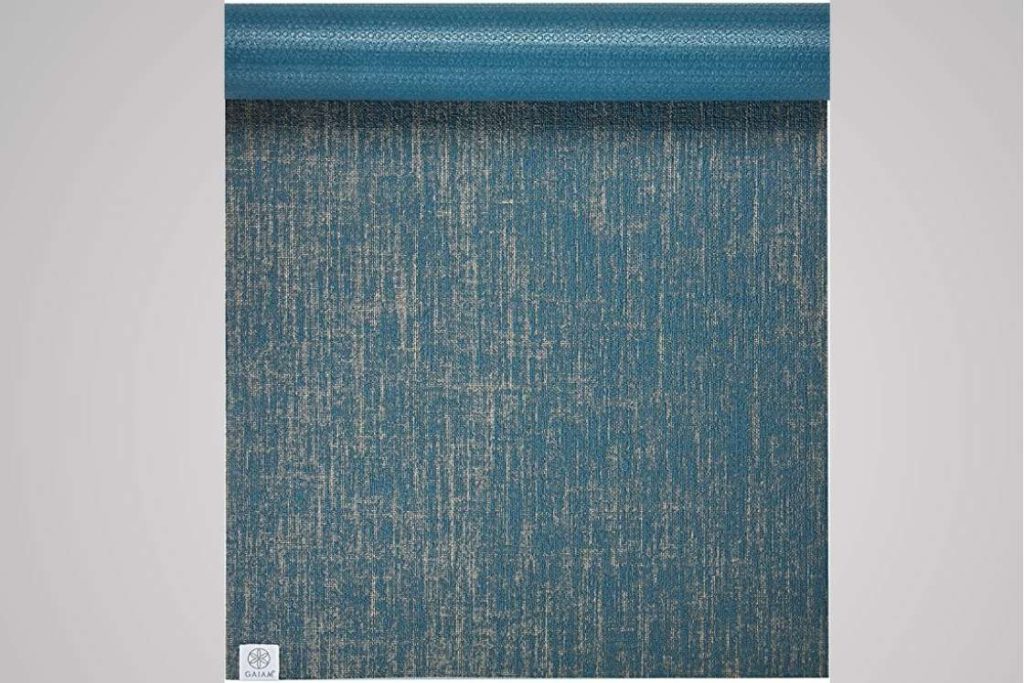
Jute as a natural material should not require much explanation. This vegetable fibre has been popular with humans throughout history. We have always used jute to weave curtains, cushion covers, rugs, carpets, and such. The question here is how well it fares when it comes to yoga mats. The jute yoga mats are usually blended with a percentage of Polymer Environmental Resin.
Pros of Jute Yoga Mats
- Jute is obviously highly biodegradable. And even the production requires minimum pesticides, so leaves a minimum carbon footprint.
- The crude texture of Jute will probably give you the best grip and balance of all the yoga mats.
- Both jute and PER are durable materials that can withstand long-term wear and tear.
- Jute yoga mats are weather resistant. Issues like sunlight, moisture, rains, and such will not degrade the quality of your mat.
- Jute mats are very lightweight, giving them easy handling.
- Jute as a material is also very friendly to your health. You can inhale directly off these mats, without the risk of inhaling anything toxic. Jute doesn’t pose any threat to your skin as well.
- The material has high breathability, so it won’t stink on storing.
Cons.
- Although the blended PER adds some cushioning, still compared to rubber, foam, and PVC, the cushioning is far less.
- Jute has low heat and chemical resistance.
- Low flexibility of jute makes portability an issue.
- Jute as a natural fiber is also poor in insulation, and thus prone to heat and electric absorption.
- The availability of jute mats can bother you at times, especially during seasons when the production of jute is low.
- The price too is significantly high; almost 5 times as high as the cheapest PVC mats
8. Cotton and Hemp
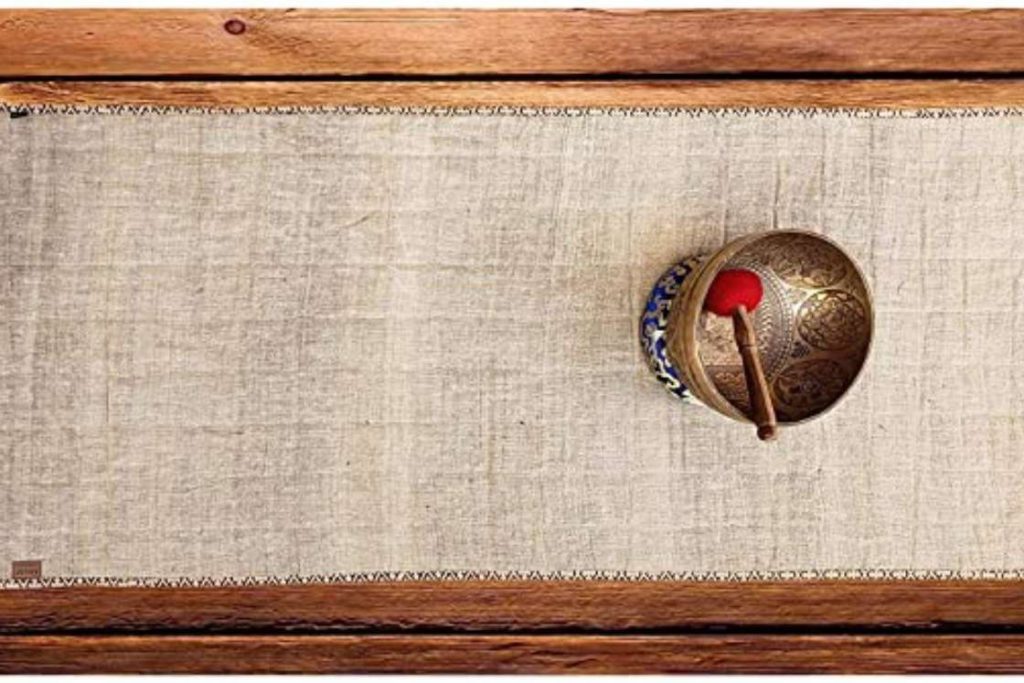
Cotton has been the preferred choice of fabric for any cloth across the globe, since ages. The cotton cloths were in fact one of the first yoga mats used by the early yogis. Very few other fibers are as comfortable and soft as cotton, but durability is an issue. Cotton is more appropriate for delicate and sophisticated use. The rough nature of practicing asanas can be too hot to handle for cotton. This is why most cotton yoga mats are blended with hemp, to give them the required tensile strength and durability. There are, however, some mats that are purely of hemp.
Pros of Cotton Hemp Yoga Mat
- Cotton hemp yoga mats are recyclable and biodegradable.
- These mats are easily available everywhere and at all times.
- These mats will easily absorb sweat.
- Cotton and hemp mats are very comfortable and give you good cushioning.
- The texture of the cotton and hemp blend is appropriate for generating posture grip.
- Cotton is very lightweight and can be easily carried everywhere.
- The cotton and hemp blend mats are also easy folded, without any damage to quality.
- The pure hemp-based yoga mats are very high on durability and will last you a lifetime, they have a high breathability as well, keeping them a cooling ability.
Cons of Cotton Hemp Yoga Mat
- The resistance to elements like heat, moisture, air and such, is very low. With usage, the condition of these mats will deteriorate. In short, low weather resistance.
- Wear and tear resistance is also low. These mats will not hold up to repeated rough usage.
- Poor insulation also results in heat and shock absorption, thus increasing related accident chances.
- These mats are not at all cost-effective.
- Although biodegradable, the production of these mats leave a high carbon footprint. Especially since the production of cotton is a pesticide intensive process, and requires a lot of water.
- The cotton mats have low sticky properties that will distract your practice sessions and your balance.
- The pure hemp based mats have a poor degree of comfort.
9. Cork
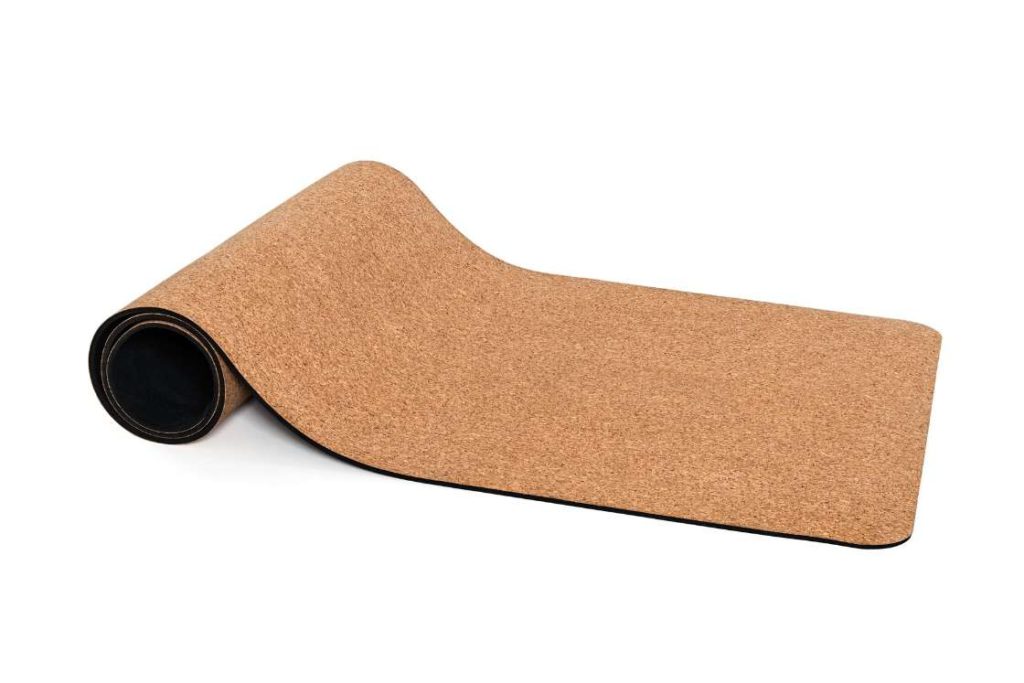
Cork is a relatively new material when it comes to yoga mats. It is developed from tree bark, making it absolutely natural. Cork in its natural sense will simply slip off the floor, thus all cork yoga mats have a base of PTE or rubber, to keep them stuck to the ground. Like the other natural materials, cork mats feel good to use, but they come with a range of pros and cons.
Check Now: Best Cork Yoga Mats Available Online
Pros of Cork Yoga Mats
- Biodegradable and it doesn’t damage the trees during harvesting as well.
- Cork is also a renewable resource.
- Cork mats are very easy to clean
- These mats have the texture of a bark, which gives them a good grip and balance.
- Cork can absorb sweat easily.
- Cork mats have the right blend of toughness and softness, that give them the ideal cushion.
- Yoga mats with cork material are a very breathable material that absorbs and dissipates body heat, which will prove helpful in lying down poses.
- Cork as a material is quite friendly to your skin.
Cons of Cork Yoga Mats
- Cork mats are costly when compared to your average industrial-grade yoga mats.
- Cork mats are also not as easily available as rubber, PVC, EVA, or PER mats.
- These mats are not weather resistant and have poor tensile strength as well. These make the cork mats low on durability when compared to the likes of natural rubber.
- Cork has poor insulation, making them prone to heat and electric-related accidents.
- Cork mats have low flexibility and compression, which resists folding and bending.
So, what is the best material for a yoga mat?
Well, it always depends on your choice and the need of the hour. If safety and comfortability are your only concern and you are a beginner, then TPE (Thermoplastic Elastomer) yoga mats would best for you. From the price point of view, yoga mats made of PVC material would give you multiple options. However, eco-friendly mats come from a variety of sources, including natural rubber, organic cotton, and jute.





Hey!
Thank you for enlightening me with your blog. I wanted to get a yoga mat but, wasn’t sure which one to buy. Now, I have a clear knowledge.
Keep up the good work.